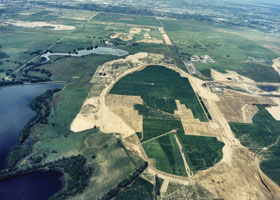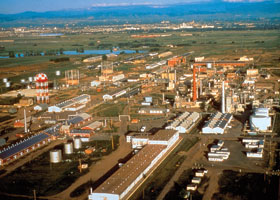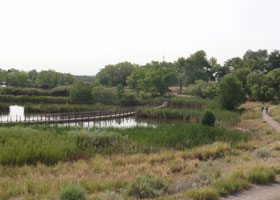Rebuilding a Chemical Wasteland

Rocky Mountain Arsenal National Wildlife Refuge, northeast of Denver, Colorado, looks a lot like other wildlife parks. Graphic storyboards display the site’s history in the visitor center, while, in the lobby, a stuffed bison peers somewhat menacingly toward the gift shop. Outside, dry prairie grasslands are dotted with mounds that regularly erupt with prairie dogs.
But unlike most national parks, this 15,000-acre refuge sits atop one of the most poisoned places on earth. For decades, beginning in 1942, Congress tasked these 27 square miles of Colorado farmland with doing the nation’s dirty work.
The Army post built there in the midst of World War II produced the nerve agent sarin, as well as mustard gas and napalm. When chemical weapon production wound down, the arsenal’s mission became the destruction of stockpiled weapons and, for a time, blending rocket fuel. For 30 years, parts of the post were leased to Shell Oil Company and other companies producing now-banned pesticides like DDT.

Until 1982, the Army and Shell discarded contaminated waste into unlined ponds, injected it into deep wells, and buried it in trenches—disposal practices that were once considered acceptable. But these toxic leftovers would earn the arsenal Superfund designation and require a $2 billion cleanup program.
Sherry James of the U.S. Fish and Wildlife Service (FWS), is director of the refuge’s visitor’s center and has worked at the site since 1990. She created many of the center’s historical exhibits.
“It’s a complicated story,” James says. “We wanted to give people a feel for what the land has been through.”
Leaks, Faults and Bomblets

Thanks to its thoroughly contaminated water, soil and buildings, Rocky Mountain Arsenal landed on the U.S. Environmental Protection Agency’s (EPA’s) Superfund National Priorities List in 1987. Years of investigation and legal wrangling led to an agreement that called for the Army and Shell Oil Company to remediate the contamination and for the FWS to manage the wildlife and habitat once the cleanup was accomplished. The massive campaign would be monitored by the EPA, the Colorado Department of Public Health and Environment and the local health department.
According to the FWS, a three-pronged approach was needed to deal with the contamination: treating the contaminated groundwater and preventing its spread off-post; excavating and consolidating the contaminated soil; and demolishing hundreds of structures
Liquid chemical waste produced at the arsenal from 1942 to 1957 was poured into unlined ponds, according to the U.S. Army Corps of Engineers. These contaminants seeped into groundwater flowing beneath the arsenal. Crop damage off-post in the 1950s alerted the Army that contaminants were reaching wells used for irrigation
To stop the flow of contaminants, in 1961 the Army drilled a 12,045-foot-deep disposal well far below the groundwater and injected about 165 million gallons of contaminated waste. But after a swarm of earthquakes in the area, they stopped use of the well in 1966. “The theory is that our fluids were lubricating the fault and that encouraged the shifting that took place and caused the tremors,” says Charles Scharmann, an engineer on the arsenal’s cleanup team since 1990 who became project manager in 2000. Scharmann says the deep well was sealed and closed in 1985.

The Army and Shell maintain about 1,000 groundwater-monitoring wells to detect chemicals and operate five water treatment facilities, including one off-post. The plants draw out groundwater, remove chemicals and re-inject it into the aquifer. The treated water then helps flush out more chemicals that are removed at another plant downstream.
The refuge was closed for a month in late summer 2012 so the Army and Shell could drill eight new groundwater-monitoring wells in response to a newly discovered chemical spread.
“That project actually was a fairly small one in the grand scheme of things,” says Scharmann. “At one point we had over 2,000 wells out here.”
Water treatment will continue for a long time, though 1,000 monitoring wells and a water treatment plant have already been closed. “Of the five groundwater-treatment plants we have left, probably two of those will be operating for many, many decades,” Scharmann says.
The contaminated soil needed a different type of cleanup. The Army buried contaminated soil and debris in hazardous waste landfills protected with two or three liners. The areas are fenced, the liner systems are monitored for leaks and the landfills are covered with four feet of soil topped by 16 inches of crushed concrete and vegetation. That concrete—all two million tons of it—came from the former runways of Denver’s Stapleton Airport which closed in 1995.
As parcels of arsenal land were decontaminated, they were removed from the Superfund National Priorities List and transferred to the FWS to become an urban wildlife sanctuary. Only the groundwater remains on the National Priorities List.
Of course, cleaning up a former chemical weapons site means occasional surprise discoveries of chemical weapons. In 2000, workers discovered 10 sarin bomblets
“We spent about $10 million destroying them,” says Scharmann. “It’s an expensive operation but it’s one that can certify we didn’t have any release of sarin into the environment.”
Calming Fears and Moving Forward
Residents near the Rocky Mountain Arsenal have been forced to live with ongoing worries over the quality of their water. Sandy Horrocks, who worked on arsenal issues for 10 years representing the Sierra Club’s Rocky Mountain Chapter, says the community “was really worked up about drinking water.” Those living in Commerce City, a community of 47,000 bordering the arsenal, have faced particular fears. Commerce City Mayor Sean Ford says residents were right to be disturbed about the drinking water contamination. “There were some upset people and I don’t blame them,” he says
Ford added that the Army fixed the problem by connecting Commerce City residents using well water to a municipal water supply and credits the Army, the EPA and other agencies with working to-gether, providing “a sense of calm to the community.”
Commerce City Councilperson Rene Bullock says initially there were groups that “wanted the arsenal completely cleaned up, closed down and a big 20-foot fence put around it. We knew that couldn’t be done,” he adds. Bullock worked for years on two citizen’s advisory groups during the remediation. He says they couldn’t “remediate it back to 1944.”
Mayor Ford says others pushed to have the toxic waste moved elsewhere. “I don’t think that’s fair,” he says. The Army’s strategy of containing, securing and monitoring the solid waste insured public safety without relocating the problem, according the mayor.
Bullock says his city calls the arsenal its “diamond” since Commerce City surrounds the arsenal on three sides. He says the refuge has “become a benefit to the community, not a hazard.”
Commerce City acquired 917 acres of remediated arsenal land in 2004 and built a new city hall on it. “I put my own office on a piece of that land. I think that says a lot to the fact I think it’s safe,” Mayor Ford adds.
From Wasteland to Refuge
Today, Rocky Mountain Arsenal is trans-formed. “We’ve done almost all the act-ive remediation,” Scharmann says, adding that “the contamination that remains there needs to be managed long term.”
The EPA will remain engaged, too. “At any site where we leave waste in place even if it’s capped, covered, monitored and secured, we come back every five years and do a review to make sure that remedy remains protective,” says Jennifer Chergo, a spokesperson with the Denver EPA.
In the meantime, the former chemical weapons site celebrated National Wildlife Refuge Day on October 13, with family-focused activities, nature films and exhibits. Visitors could explore eight miles of hiking trails and the refuge debuted a self-guided auto tour. Refuge director James says at least 300 people came out to celebrate, despite some intermittent rain.
All told, about 35,000 people visited the refuge in 2012. That’s not much compared to other U.S. parks, but the number of visitors is increasing.
Today the Rocky Mountain Arsenal National Wildlife Refuge’s $7.4 million visitor center, which opened in 2011, features sustainable construction strategies like geothermal heating and cooling, copper roof paint that reflects sun in summer and absorbs warmth in winter, recycled tile and recycled asphalt in the parking lot
But perhaps the biggest attraction at the refuge is the bison, which were reintroduced onto the property in 2007 as part of a federal conservation program. Seventy bison now roam the former arsenal.
“We couldn’t do enough bison tours,” says James. That stuffed bison in the visitor center lobby is popular, too. Adds James: “That’s our photo stop, for sure.”

